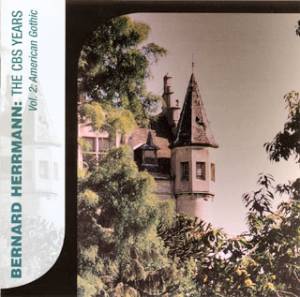************************************************************** EDITOR’s RECOMMENDATION December 2003 **************************************************************
The CBS Years Vol.2: American Gothic
Bernard Herrmann
Original mono recordings from 1944-58
Available on Prometheus PCD 153
Running time: 69.22

The music here is drawn from six scores written by Bernard Herrmann for CBS radio and television shows between 1944-58, all of which ended-up as library music tracked into many later shows between the latter part of the 1950's and early 1960's. This disc follows Volume 1, also reviewed this month, which is devoted to music Herrmann wrote, rather atypically, for the Western genre.
The work on this second volume is rather better, largely because Herrmann was as a composer profoundly unsuited to the bright open spaces of the traditional western, and is here back in much more familiar territory. The programme opens with the furious military snare driven opening and closing titles for and unsold pilot called Landmark (1956), which is fine if far from essential. However, it is rapidly followed by the major highlight of the album, a 14 movement suite from a 1944 radio broadcast devoted to the poet Walt Whitman. Herrmann's score is lovely, lyrical, romantic and melancholy, clearly an antecedent of his marvellous The Ghost and Mrs. Muir (1947), yet also offering hints of The Snows of Kilimanjiro (1952) and the masterly Vertigo (1958) still over a decade in the future. The sound quality leaves much to be desired, but the music fills in a significant gap in the composer's musical history for serious collectors. What would be most appreciated now is a first-rate new performance with excellent modern sound.
The audio is better for the 10 minute single movement suite from Ethan Allen, music composed for a proposed 1957 pilot about the leader of the Green Mountain Boys band of rebels during the American War of Independence. Scored for 10 brass players and timpani, Jon Burlingame suggests in his booklet notes that the work might be considered a companion to Have Gun, Will Travel from the same period. Its good Herrmann not too far removed from the style of adventure music he was writing for Ray Harryhausen movies at the time, but is nevertheless nothing particularly memorable.
"The Desert Suite" really belongs to Vol.1 of this series, but is included here simply because it wouldn't fit on the previous disc. In 1957 Herrmann recorded 4 suites of generic Western music. Three are on Vol.1, and the fourth appears here. The sound is very thin and skirts the edge of distortion much of the time, the seven tracks really adding nothing to our knowledge or enjoyment of the composer's music. Routine generic fare designed to be tracked into any number of episodes of routine Western shows, available here for completists.
Collector's Item was a 1958 pilot for a crime drama set in the art world starring Vincent Price and Peter Lorre. Scored for an ensemble of 15 – seven brass, five woodwinds, vibes, harp and timpani – there is a quality of dark brooding suspense and menacing action to the eight minute suite having much in common with Herrmann's work on the classic Harryhausen adventures and Hitchcock thrillers he was working on at the same period. Highly enjoyable, and the sound is reasonable too.
The Moat Farm Murders is music from another 1944 radio show, accurately described by Herrmann biographer Steven C. Smith as "…icy as a corpse's fingertips". The sound is bold and dynamic given its vintage and the music delivers a considerable chilling intensity with its highly inventive scoring. The suite runs for just under 8 minutes in a single movement, leading to the album finale, another suite of equal length from a 1956 radio production of Brave New World, which had narration by Aldous Huxley himself. Scored for timpani, electric organ, harp and an array of unspecified tuned percussion, this slow motion bad dream of a score sits somewhere between Herrmann's The Day The Earth Stood Still (1951) and Fahrenheit 451 (1966) as music which evokes a science fiction world through coldly beautiful percussion and elegant formality. The sound is free from significant distortion and is detailed and clear.
A mixed bag, but the best is very good. Far superior to Vol.1 and well worth adding to any Herrmann collection.
Gary Dalkin
4
Return to Index